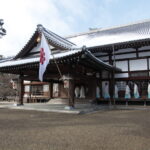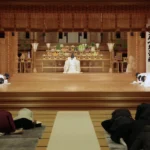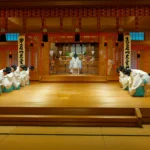In 1892, Oomoto Foundress Nao Deguchi became possessed by God. Through Nao’s automatic writing under this possession, the Reconstruction of the Greater World was declared. Although illiterate, Nao recorded ten thousand 20-page volumes of warnings and prophecies for this world before she passed away in 1918.
In 1898, Oomoto Co-Founder Onisaburo Deguchi received divine instructions to spend a week in spiritual training on the sacred Mountain of Takakuma, located in his hometown of Kameoka, Kyoto Prefecture. There he earned the esoteric power of insight into the past, present, and future of the material world, the realm of the dead, and the spiritual world. He came to understand his role in the spiritual salvation of humankind at this time. The following year, he acted upon divine commands to become an adherent of Oomoto, marry the Foundress’ fifth daughter, Sumiko, and, together with the Foundress, construct the foundations of the Oomoto religion.
In 1917, Onisaburo began publishing a seven-volume work “Oomoto Shinyu” that interprets Nao’s Scriptures. Beginning in 1921, Onisaburo drew upon experience gained in his religious training on Mt. Takakuma to dictate the “Tales from the Spiritual World“, with the aim of world salvation, published as eighty-three books in eighty-one volumes.
In 1919, Oomoto acquired the ruins of Kameoka castle, and there established a temporal reproduction of the Spiritual Kingdom. There “Ten’on-kyo” was created as the center for the dissemination of Divine teachings. In Ayabe (where the Foundress was first possessed by God), “Baisho-en” was built as the center of Oomoto’s religious worship and ceremonies.
From the time that Onisaburo entered Oomoto, the vigor and popularity of its teachings increased tremendously, so much so that the national authorities felt that they could not overlook the power of Oomoto’s influence. Consequently, what is called the First Oomoto Incident took place in 1921, upon which Oomoto, its activities and adherents were greatly suppressed by the Japanese government. This was followed by the Second Oomoto Incident in 1935, when the authorities vowed to “obliterate Oomoto from the face of this earth.”
In 1945, however, the Second Oomoto Incident was entirely resolved by acquittal in the Japanese courts. The following year, Oomoto started up again under the name of “Aizen-en,” or “Garden of Love and Virtue.” Naohi Deguchi, the eldest daughter of Co-Founder Onisaburo and the Second Spiritual Leader, succeeded as the Third Spiritual Leader in 1952, and revived the organization under the name of Oomoto. She worked together with her husband, Hidemaru Deguchi, to purify people’s hearts and souls in order to usher in the era of eternal world peace.
In 1990 Kiyoko Deguchi, the third daughter of Naohi and Hidemaru, became the Fourth Spiritual Leader of Oomoto. In observance of the 1992 100th anniversary of Oomoto’s founding, construction of “Chosei-den” (“Hall of Immortality”) — a shrine worshipping the Creator of the Universe — was completed. Based on its 100-year history, Oomoto’s divine work is poised to greet a new era.
==> Chronology of Inter-Religious Activity at Oomoto 1836 — 1996
==> The History of Oomoto (from the “Oomoto International” Jan.– Mar. 1980 — Apr.– Jun. 1982)
Archives (from the “Oomoto International”)
==> The Ancestors; Friends or Foes? (Apr.-Jun. 1987)
==> Tsukinamisai; The Sabbath of Shinto (Jan.-Jun. 1983)
==> The Poem Festival at Oomoto; An Ancient Rite Lives Again (Oct.-Dec. 1981)
==> Purification of the Universe; Oomoto’s Setsubun Festival (Apr.-Jun. 1981)



